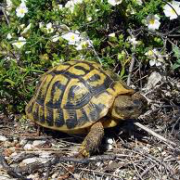HIBERNATING YOUR TORTOISE
At this time of year we do receive many telephone calls enquiring about tortoise hibernation.
HOW DO I PREPARE FOR HIBERNATION?
To make sure the tortoise is in the best possible condition for hibernating, a good diet should be provided. Dandelion, timothy grass, clover, English plantain, land cress, water cress, coriander, pea leaves (also pods), alfalfa, broccoli, asparagus or chicory would be suitable vegetation. Some greens contain oxalates that prevent calcium absorption. These should only be used in very small quantities if at all (e.g. chives, parsley, spinach, beet leaves, chard and bok choy). It is also advisable to use a good quality calcium & vitamin D3 supplement such as Nutrobal.
WHEN SHOULD I START?
You should decide whether your tortoise has put on suitable weight and is fit for hibernation around the middle of August. In order to survive hibernation your tortoise should have put on sufficient stores of fat (and with it, vitamins and water) during the most active summer months. From August onwards the tortoise’s appetite will start to decline. So if he is not fit in August, he won’t be in October/November.
We advise that you have your tortoise examined by a vet in late August or early September to check for signs of disease. Once it has been established that the animal is in good condition for hibernation, an approximate date should be planned for starting hibernation – usually the end of October or early November. This is important as the tortoise needs to have all food removed 6 weeks prior to this date, so that his intestines are free of food during hibernation. If this is not done, bacteria can grow on the rotting meal inside the tortoise and kill the tortoise during hibernation. While food should be withheld, drinking should be encouraged with daily shallow water baths in the 2 weeks prior to hibernation.
WHAT DO I NEED?
There are two main methods: a refrigerator or well-insulated box. The refrigerator is the preferred method but is not always practical.
1. Refrigerator method
A refrigerator is an ideal place to hibernate a tortoise as it provides a controlled cold temperature environment above freezing. To maintain hibernation, the tortoise must be kept between 10C and 100C (ideally at 50C). It is preferable to use a separate fridge – not one used to store food – due to food hygiene concerns. The fridge should be placed in a room where the temperature will be above freezing for the whole winter. You need a Max/Min digital thermometer with a probe. They cost about £12.00. Place the probe inside the fridge and slowly adjust the fridge thermostat until a consistent temperature of roughly 50C is achieved.
You need a plastic sandwich box a little larger than your tortoise. Make some air holes in the lid and place a pad of kitchen paper at the bottom of the box. Some authors like using a mixture of compost and sand in the bottom of the box, but I prefer the kitchen paper as it is easy to clean and does not harbour large numbers of bacteria. When hibernation time comes, place the tortoise inside the sandwich box which you then place in the fridge. Check your tortoise visually every day and weigh it twice a week. Just opening the fridge door provides enough fresh air. An average fridge will contain enough oxygen to sustain a hibernating tortoise for 1-2 weeks. You should monitor the temperature inside the fridge daily and make any necessary adjustments to the thermostat.
2. Box Method
This is the more traditional method but requires closer monitoring and is more difficult to monitor. Make a large outer box out of strong cardboard. It should be about 3ft or 1m square. Half-fill it with an insulating material. Polystyrene packing chips are ideal as they allow air flow, are a good insulator and do not harbour fungi and bacteria. Under no circumstances should hay or straw be used (as seen on Blue Peter!). These provide a very good place for fungi and bacteria to grow and can lead to very bad or fatal lung infections. You need a plastic sandwich box a little larger than the tortoise. Make some air holes in the lid and place a thick pad of kitchen paper at the bottom of the box. This provides air space and as the tortoise moves around during hibernation prevents the tortoise burrowing through the protective insulation. Place the tortoise in the plastic sandwich box, and then place that in the middle of the half filled cardboard box, on top of the insulation. Fill the cardboard box completely with the polystyrene chips. Place the cardboard box in a room where the temperature does not fluctuate above 100C or below 10C for a prolonged period of time and is free of rats or mice.
To monitor this, a Max/Min digital thermometer with a probe that reads the inside of the cardboard box (i.e. around the probe) and outside (i.e. around the display) is needed. Place the probe inside the centre of the insulated box near the tortoise with the display on the outside the box. This will tell you the hottest and coldest it has got to inside and outside the box. If the temperature inside the plastic box drops below freezing the tortoise will die, and if it stays above 10 0C for a prolonged time the tortoise will drift in and out of hibernation using up vital body reserves. The tortoise should ideally be checked daily and weighed twice a week. The insulation only slows the effects of room temperature variation on the tortoise.
INITIATING AND MONITORING HIBERNATION
In the wild, a tortoise will only hibernate for 1-2½ months depending on the species and the country. Our winter lasts for 4-5mths. This is far too long for the tortoise’s reserves, so a tortoise should never be hibernated for this length of time. In the lead-up to hibernation (from the end of summer), the tortoise should be kept warm and in a vivarium or tortoise table. Feeding should be kept up as normal until 6 weeks before the intended date of hibernation when it should be withdrawn completely. The tortoise should still be kept warm and given regular shallow water baths to encourage it to drink. Over the final 1-2 weeks the temperature should be reduced in the vivarium or table. The tortoise will slow down before being placed in the hibernation container. It should have drunk but not urinated. This is very important, as water is reabsorbed from the bladder during hibernation. Do NOT hibernate the tortoise if it has urinated recently and not drunk. Weigh the tortoise, then place it inside the plastic box which is then placed inside fridge or the insulated cardboard box. The tortoise should be visually checked daily for any signs of problems and the maximum and minimum temperature recorded and then reset. The tortoise should be weighed twice a week. It is normal for a healthy tortoise to lose 1% of its total body weight per month. There is no impact on hibernation or risk of “waking up” the tortoise by these checks. If a tortoise is losing too much weight, urinates or there are signs of any disease, the tortoise should be woken up immediately. If using the box method and the temperature of the room is consistently to low or too high, the box should be moved to a room with a more suitable environment.
BRINGING OUT OF HIBERNATION (WAKING UP)
If you use the refrigerator technique, you are controlling the temperature so the tortoise will not wake up by itself, so after 2-3 months of hibernation you will need to intiate this process. If you are using the box technique then if the tortoise starts waking up by itself (i.e. the temperature stays above 100C and the tortoise seems to be moving around) or it has been in hibernation for 2-3 months, it is time to bring it out of hibernation.
To do this, remove the tortoise from the fridge and place it near the heat source in the vivarium or tortoise table/box. The tortoise should gradually warm up over 2-3 hours and you should see it gradually becoming more active. The most important thing once it is active, is to encourage it to drink. This is best achieved by placing the tortoise in a shallow bath of warm water. Once the tortoise has drunk, the next important thing is to encourage it to eat. The tortoise should initially take food within the first 24 hours and be eating well within 72 hours. If this does not happen then it is unlikely the tortoise will start eating by itself. This known as “post hibernational anorexia”. When the tortoise first comes out of hibernation there is a surge of glucose released from the liver. This provides the tortoise with enough energy to find and eat food for 24-48 hours. So after this time if the tortoise has not found food it will not have enough energy to start eating by itself. There can be other more serious reasons (e.g. infection) for the lack of appetite, so if the tortoise has not started eating well within 72 hour after coming out of hibernation, please seek veterinary help.





Leave a Reply
Want to join the discussion?Feel free to contribute!